Best Air Conditioners for Dorm Rooms
Choosing the best air conditioner for a dorm room can be a daunting task, especially with limited space and budget. But don’t worry; we’ve compiled the most important features and factors you need to consider when selecting the right air conditioner for your dorm.
Portable Air Conditioners
Portable air conditioners are a great option for cooling a dorm room due to their flexibility and ease of installation. Unlike traditional window AC units, portable air conditioners can be moved around and don’t require permanent installation, making them ideal for temporary living situations such as dorms.
Key Benefits of Portable Air Conditioners:
- Compact and Space-Saving: They are designed to be small, making them perfect for tight dorm room spaces.
- Ease of Installation: Simply set it up near a window, attach the exhaust hose, and plug it in.
- Energy-Efficiency: Many models come with energy-saving features that reduce electricity consumption, helping you save on utility bills.
- Cooling Power: Despite their size, portable air conditioners can cool small to medium-sized rooms effectively, usually between 250 to 500 square feet.
How to Choose the Best Portable AC for Your Dorm:
- BTU Rating: For optimal cooling, look for an air conditioner with a suitable BTU (British Thermal Units) rating for your room size.
- Size and Portability: Check the dimensions of the unit to ensure it fits in your dorm room without taking up too much space.
- Noise Level: Look for a quiet model to avoid disrupting your study or sleep time.
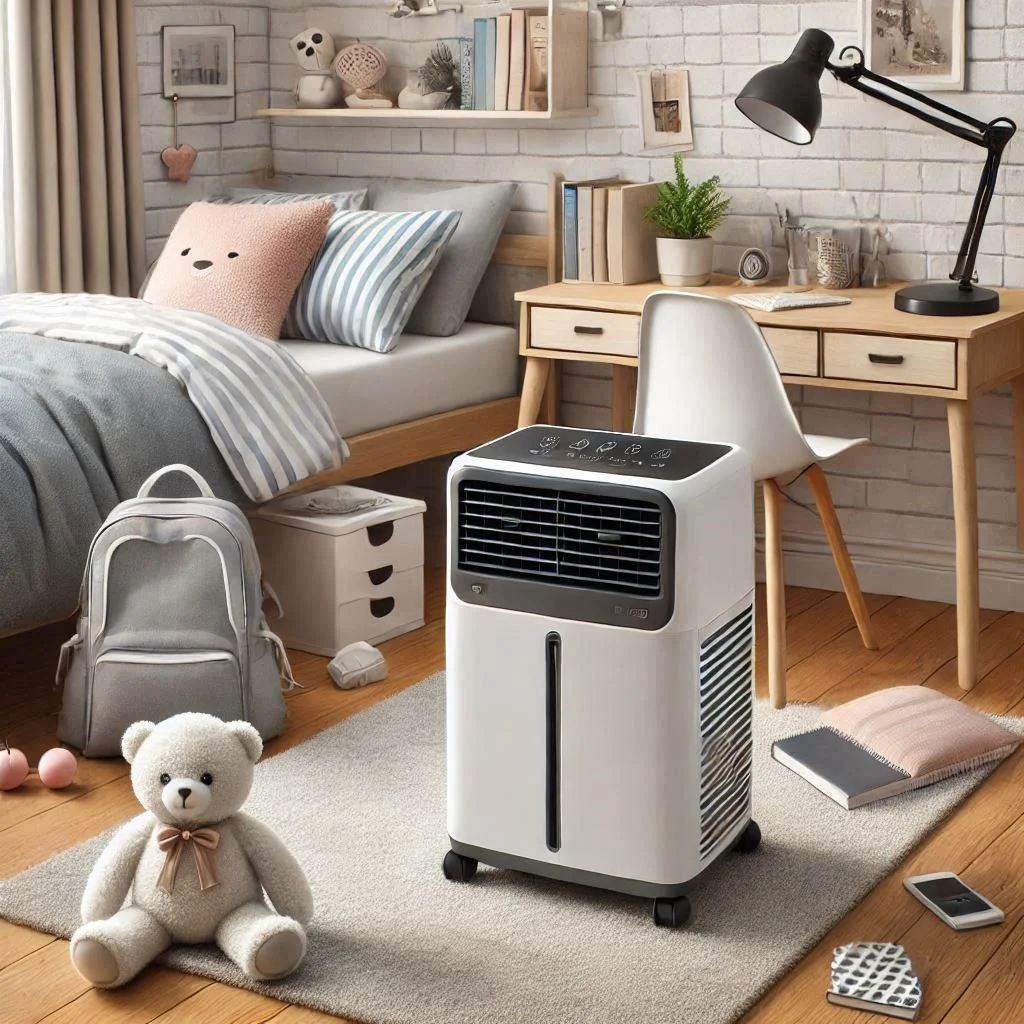
Air Cooler vs. Portable Air Conditioners
Understanding the difference between air coolers and portable air conditioners can help you make a more informed decision based on your needs.
Air Coolers: Air coolers, also known as evaporative coolers, use water to cool the air. They work by drawing in hot air, passing it through moistened filters, and releasing the cool air into the room. They are most effective in dry, hot climates.
Pros of Air Coolers:
- Energy-Efficient: Uses less power than a portable air conditioner.
- Environmentally Friendly: No chemicals used in the cooling process.
- Affordable: Generally cheaper than portable air conditioners.
Cons of Air Coolers:
- Limited Effectiveness in Humid Climates: Air coolers are less effective in humid environments because they rely on evaporation to cool the air.
- Maintenance: Requires regular refilling of water and cleaning of filters.
Portable Air Conditioners: Portable ACs, on the other hand, use refrigerants to cool the air and do not require water to operate. They are more effective in cooling spaces in both dry and humid climates.
Pros of Portable Air Conditioners:
- Versatility: Can be used in any climate, including humid conditions.
- Cooling Power: Provides more powerful and consistent cooling compared to air coolers.
Cons of Portable Air Conditioners:
- Higher Energy Consumption: Typically uses more power than air coolers.
- Price: Usually more expensive than air coolers.
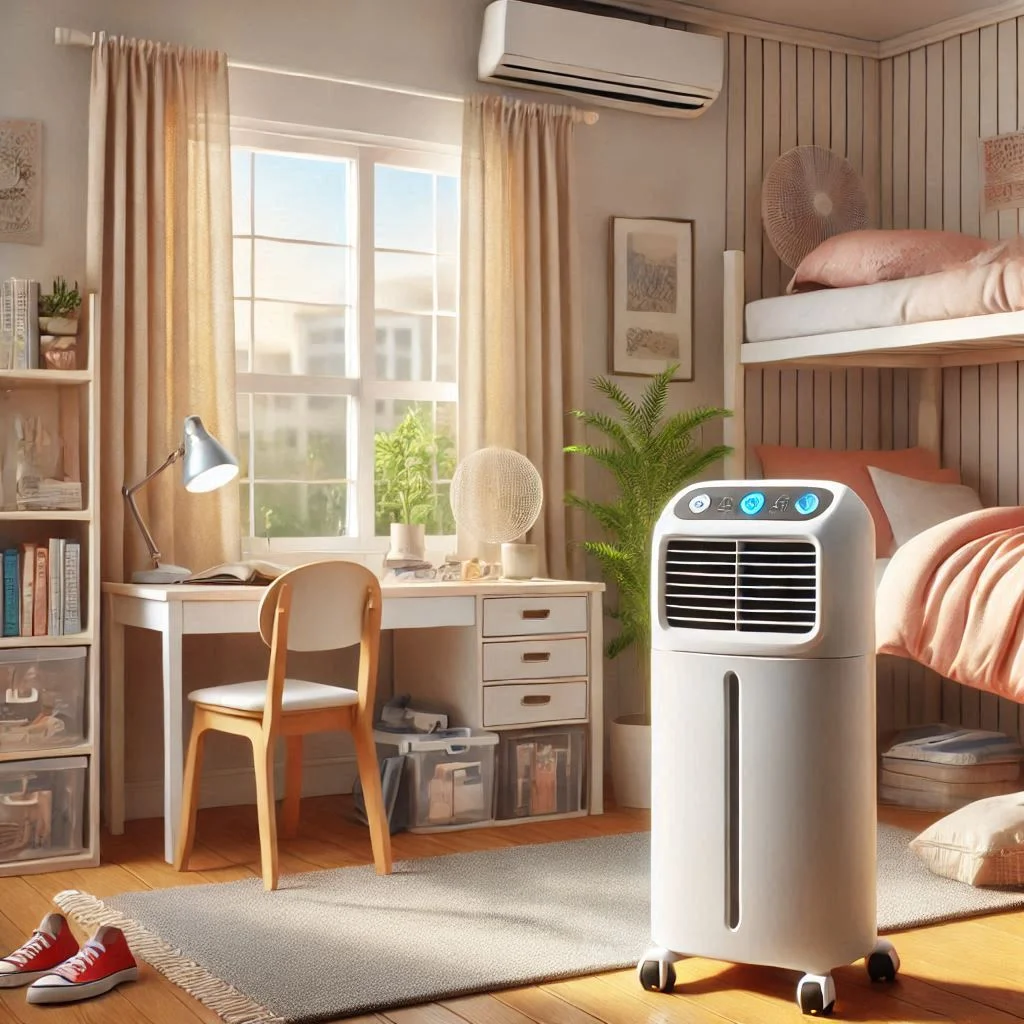
How to Cool a Dorm Room Without Using an Air Conditioner
Not everyone has the budget or space for a portable air conditioner. Fortunately, there are several ways you can cool your dorm room naturally and keep it comfortable without needing an air conditioner.
1. Purchase a Fan A fan is an inexpensive and efficient way to circulate air in your dorm room. Ceiling fans, standing fans, or box fans can create a wind-chill effect, making the room feel cooler even if the actual temperature hasn’t dropped.
2. Keep Your Blinds Closed Direct sunlight can quickly heat up a room, making it feel hotter. Keep your blinds or curtains closed during the day to block the sun’s rays and prevent heat from entering your room.
3. Invest in a Cold Mist Humidifier A cold mist humidifier not only increases moisture in the air but also helps cool the room naturally. Look for a humidifier with a cooling setting to maximize its cooling power.
4. Turn Off Unnecessary Electrical Appliances Electrical appliances such as computers, lights, and TVs can generate heat. Turn off any devices that aren’t in use to reduce the heat load in your room.
5. Shower Before Bed Taking a cool shower before bed can lower your body temperature and help you sleep better in a warm room. This method may not cool the room itself, but it provides personal relief.
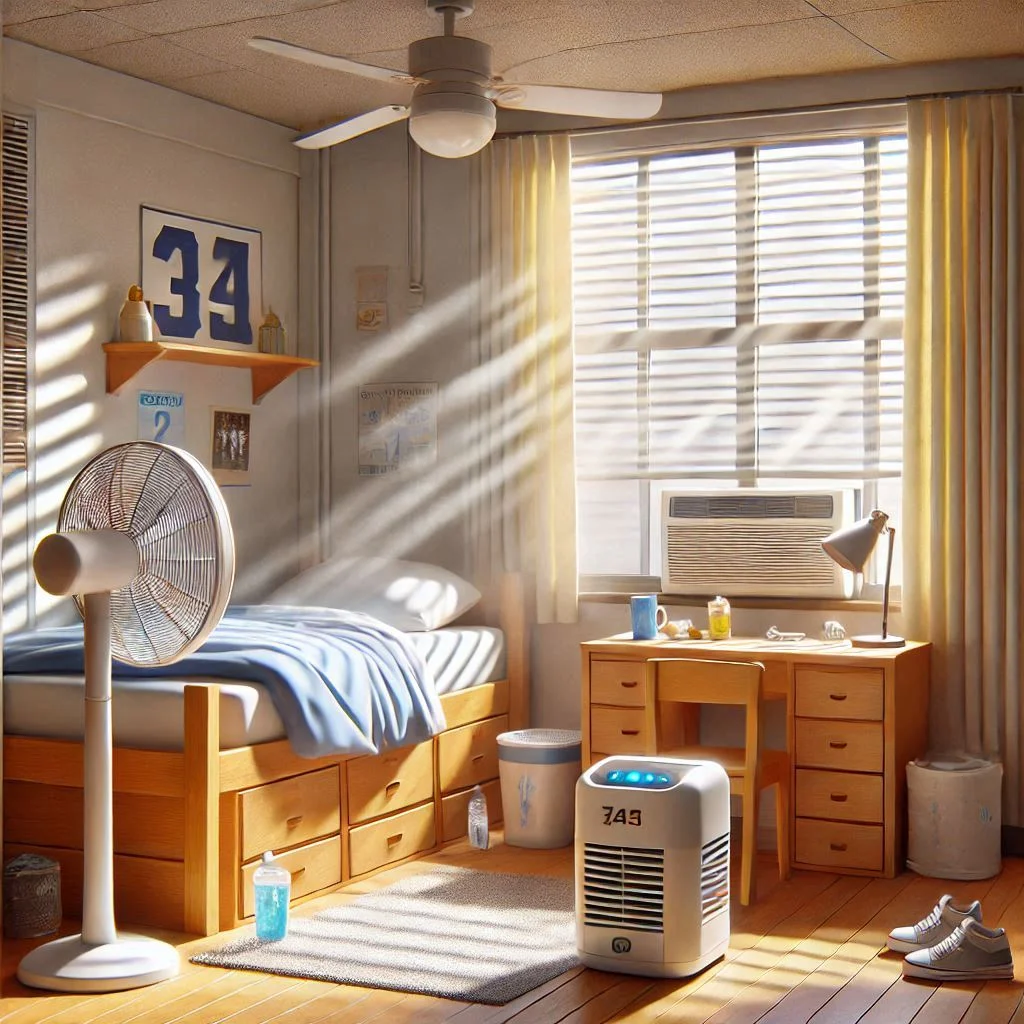
Top Portable Air Conditioners for Dorm Rooms
Portable air conditioners are an excellent choice for keeping your dorm room cool during the hot summer months. Whether you’re looking for a unit with cooling and heating options, energy efficiency, or quiet operation, there are many portable ACs to choose from. Below are some of the top portable air conditioners that offer excellent performance and convenience for dorm rooms.
FHPH132AB1 Portable Room Air Conditioner by Frigidaire
The FHPH132AB1 Portable Room Air Conditioner by Frigidaire is a popular choice for dorm rooms thanks to its efficient cooling power and compact design. This portable AC unit is equipped with a 13,000 BTU cooling capacity, making it ideal for rooms up to 500 square feet. It also features a dehumidification function, which helps maintain air quality by reducing moisture levels in your room.
Key Features:
- 13,000 BTU cooling capacity: Cools medium to large rooms effectively.
- Dehumidifier function: Removes up to 3 pints of moisture per hour.
- Energy Star rated: Ensures energy-efficient operation.
- Remote control: Easy to adjust settings from a distance.
Why Choose It for Your Dorm?
This portable air conditioner is perfect for dorms with a bit more space and can handle warmer climates. Its sleek design fits well in smaller rooms, and the energy-efficient features help lower electricity bills.
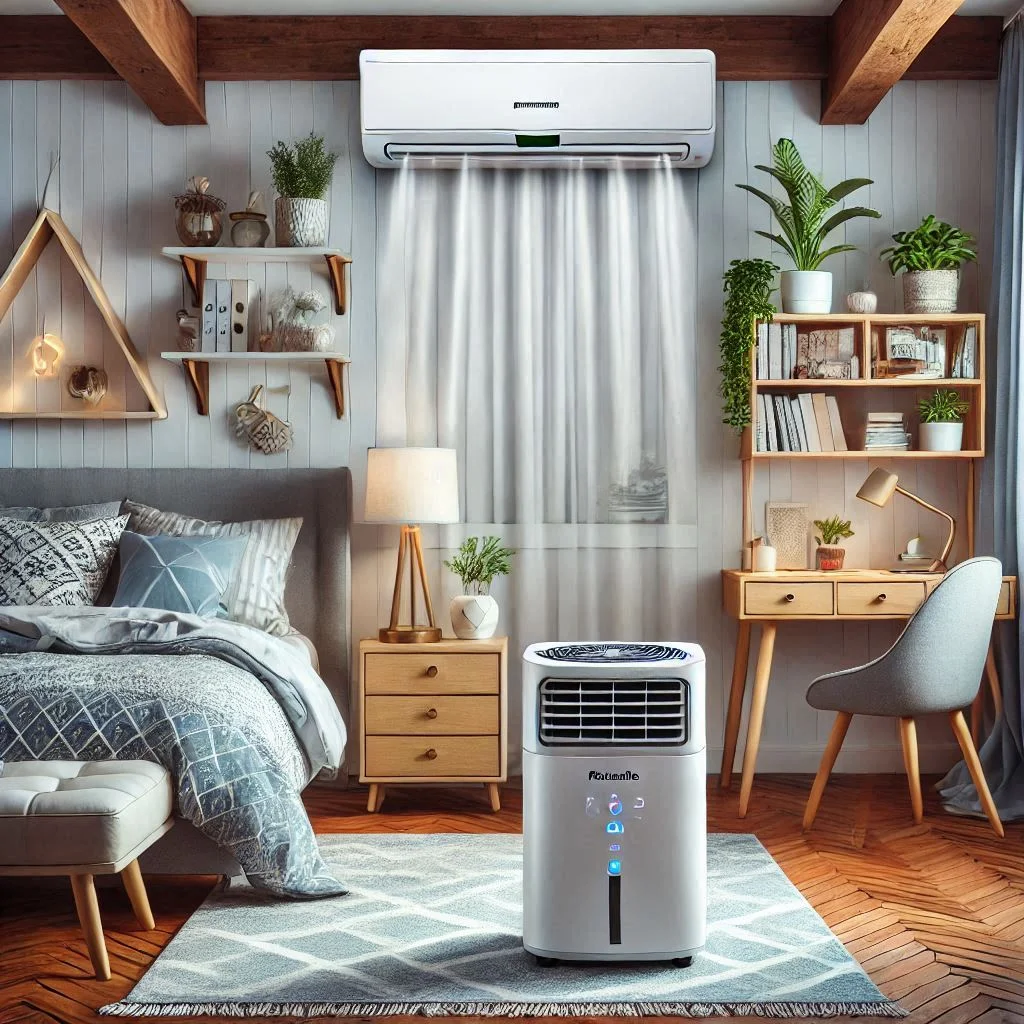
Black + Decker BPACT08WT Portable Air Conditioner
The Black + Decker BPACT08WT Portable Air Conditioner is an affordable, compact option that’s perfect for dorm rooms. With an 8,000 BTU cooling capacity, it’s ideal for smaller rooms up to 150 square feet. This unit is designed to provide effective cooling while remaining energy-efficient, making it a great option for students who want comfort without high electricity costs.
Key Features:
- 8,000 BTU cooling capacity: Ideal for smaller dorm rooms.
- 3-in-1 functionality: Works as an air conditioner, dehumidifier, and fan.
- User-friendly controls: Includes a remote control and easy-to-use digital controls.
- Quiet operation: Designed to run quietly, ensuring minimal noise during studies or sleep.
Why Choose It for Your Dorm?
The BPACT08WT is a budget-friendly choice with multiple functions. It’s perfect for smaller spaces like dorm rooms and provides reliable cooling without excessive noise.
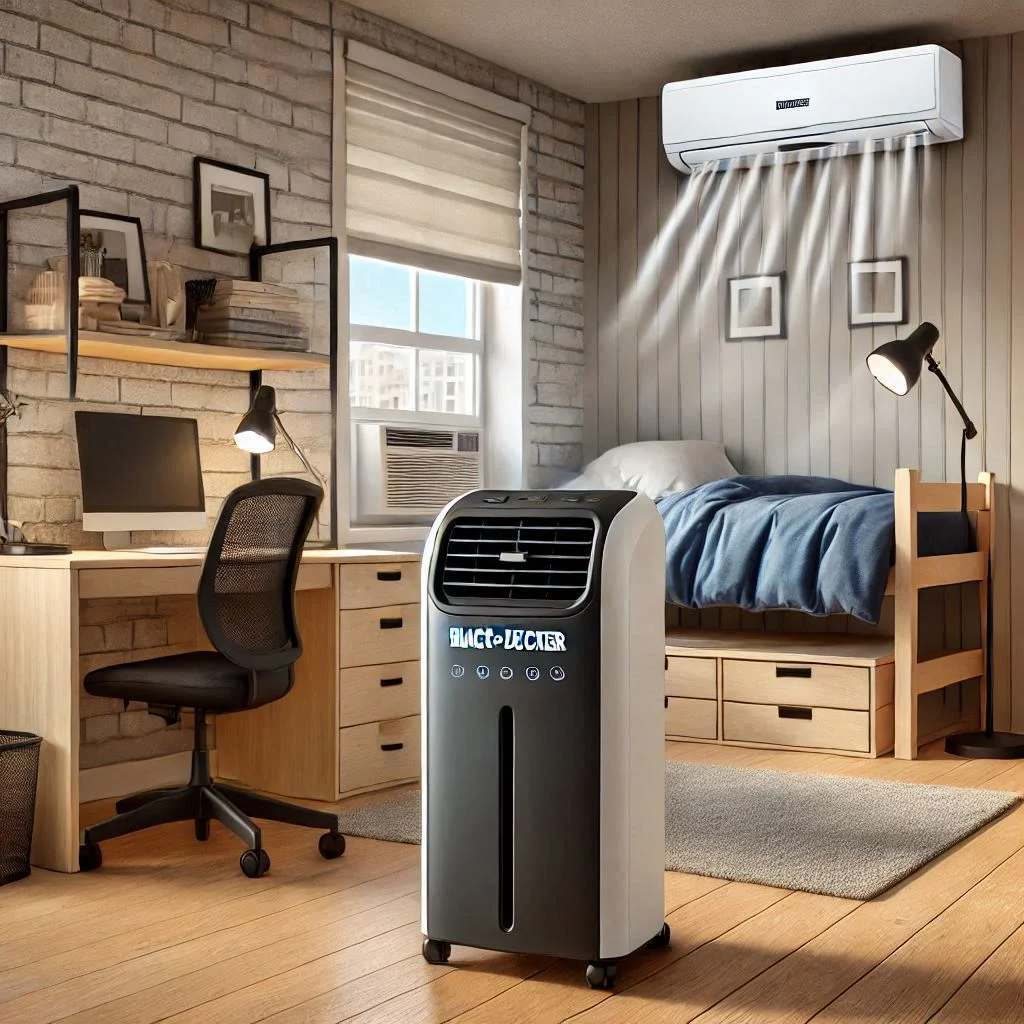
Portable Evaporative Cooler with Fan by Honeywell
The Honeywell Portable Evaporative Cooler with Fan is an eco-friendly option for dorm room cooling. While it doesn’t use refrigerants like traditional portable air conditioners, it relies on water and air to cool the room, making it an excellent option for dry climates. It’s also a more energy-efficient alternative to regular air conditioners.
Key Features:
- Evaporative cooling: Cools air by adding moisture to the air.
- Low energy consumption: Uses significantly less power than traditional AC units.
- Multi-functional: Works as a fan, humidifier, and air cooler.
- Easy to move: Lightweight and portable design.
Why Choose It for Your Dorm?
If you live in a dry area and need an environmentally friendly solution, this evaporative cooler is a great pick. It’s ideal for cooling smaller dorm rooms without consuming too much energy.
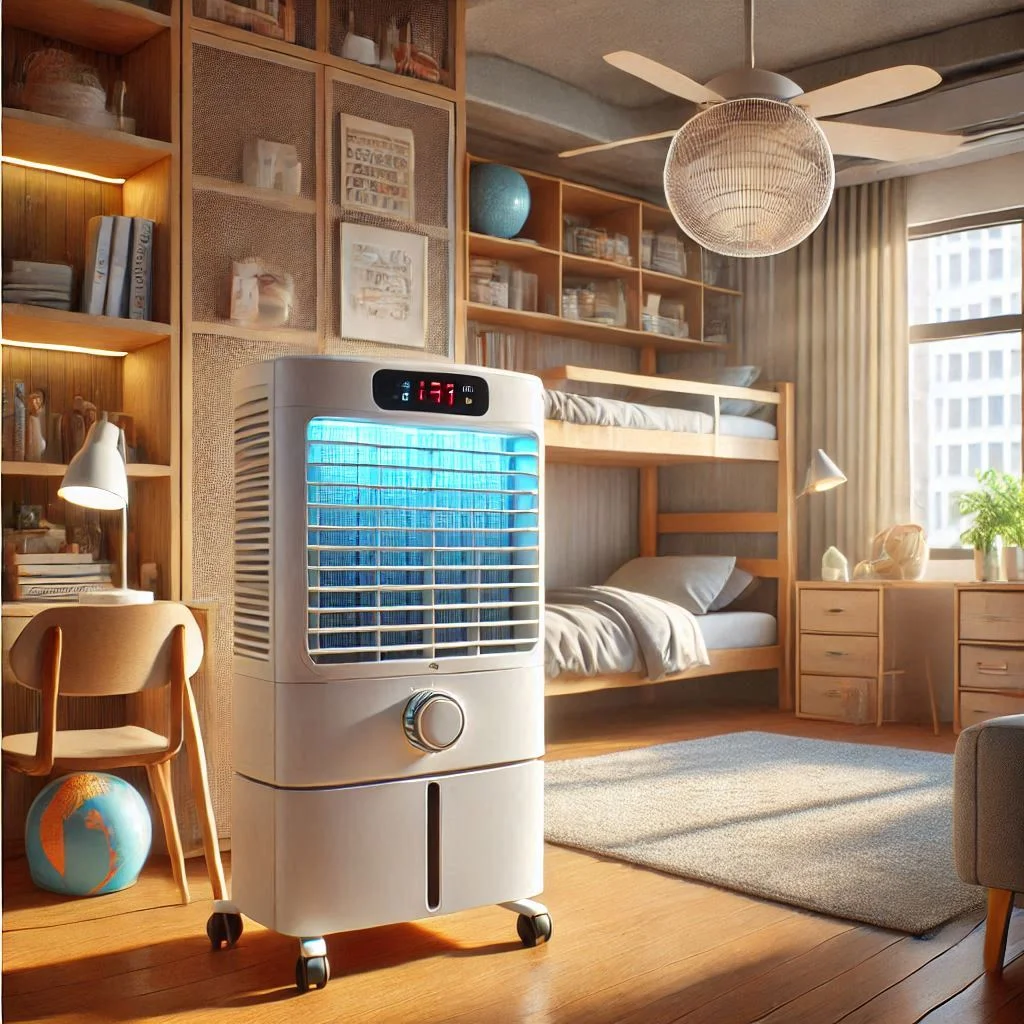
Best Buy customers often prefer the following products when searching for Dorm Room Portable Air Conditioner:
Several top-rated portable air conditioners are popular with Best Buy customers for dorm room use. These models have earned strong reviews due to their effective cooling, reliability, and energy efficiency.
Amana – 300 Sq. Ft. Portable Air Conditioner
The Amana 300 Sq. Ft. Portable Air Conditioner offers a reliable and efficient cooling solution for medium-sized dorm rooms. With a 10,000 BTU cooling capacity, it can cool rooms up to 300 square feet.
Key Features:
- 10,000 BTU cooling: Ideal for medium-sized dorm rooms.
- Energy Star rated: Saves energy while providing excellent cooling.
- Easy installation: Comes with all necessary installation components.
Insignia™ – 300 Sq. Ft. Portable Air Conditioner
The Insignia™ 300 Sq. Ft. Portable Air Conditioner is a smart choice for those who need efficient cooling in a budget-friendly package. It has a 10,000 BTU capacity, and its compact size makes it an easy fit for any dorm room.
Key Features:
- 10,000 BTU cooling: Cools up to 300 square feet effectively.
- Quiet operation: Runs quietly, ideal for peaceful dorm life.
- Remote control: Allows easy adjustments from anywhere in the room.
Keystone – 250 Sq. Ft. Portable Air Conditioner with Dehumidifier
The Keystone 250 Sq. Ft. Portable Air Conditioner is designed to cool smaller dorm rooms while offering a built-in dehumidifier to improve air quality. It has a cooling capacity of 8,000 BTU, making it suitable for spaces up to 250 square feet.
Key Features:
- 8,000 BTU cooling: Suitable for smaller rooms.
- Dehumidification mode: Removes up to 2.2 pints of moisture per hour.
- Digital controls: Easy-to-use interface with a remote control.
LG – 250 Sq. Ft. Portable Air Conditioner
The LG 250 Sq. Ft. Portable Air Conditioner is a great option for cooling smaller spaces. Its 8,000 BTU capacity ensures efficient cooling without occupying too much space in your dorm room.
Key Features:
- 8,000 BTU cooling: Ideal for small to medium dorm rooms.
- Energy-efficient: Uses less energy while providing effective cooling.
- Quiet performance: Operates quietly, perfect for a restful sleep.
Whynter – 400 Sq. Ft. Portable Air Conditioner and Heater
The Whynter 400 Sq. Ft. Portable Air Conditioner and Heater is a versatile unit that can provide both cooling and heating, making it perfect for year-round use. With a 14,000 BTU cooling capacity, it can cool larger rooms and also function as a heater during colder months.
Key Features:
- 14,000 BTU cooling and heating: Provides year-round comfort.
- Energy-efficient: Designed for low power consumption.
- Dual hose system: Ensures faster cooling and efficient performance.
Emerson Quiet Kool – Portable Air Conditioner with Remote Control
The Emerson Quiet Kool Portable Air Conditioner is perfect for those who value silent operation. With a 10,000 BTU cooling capacity, it’s designed for rooms up to 300 square feet.
Key Features:
- 10,000 BTU cooling: Ideal for small to medium-sized rooms.
- Remote control: Convenient for adjusting settings from anywhere.
- Quiet operation: Ensures a peaceful environment in your dorm room.
Whynter – 400 Sq. Ft. Portable Air Conditioner
The Whynter 400 Sq. Ft. Portable Air Conditioner is a popular pick for larger dorm rooms. This unit offers powerful cooling with 14,000 BTU and has a convenient auto-drain system.
Key Features:
- 14,000 BTU cooling: Effective for large rooms up to 400 square feet.
- Energy-efficient: Runs on low power without sacrificing performance.
- Self-evaporating system: Reduces the need for manual drainage.
Key Features to Look for in the Best Dorm Room Air Conditioners
Choosing the best air conditioner for your dorm room involves considering various features that will ensure comfort, efficiency, and convenience. When selecting a portable air conditioner or window unit, it’s crucial to focus on aspects such as smart functionality, sizing, noise levels, placement, and energy efficiency. These features directly impact the performance and usability of the AC unit in a small living space like a dorm room.
Smart Functionality
In today’s tech-driven world, smart functionality is becoming an essential feature in modern air conditioners. Many newer models offer Wi-Fi connectivity, allowing you to control your unit remotely via your smartphone or a smart home assistant like Alexa or Google Assistant. This is incredibly convenient for students who are constantly on the go, enabling them to cool their rooms before arriving or adjust settings from anywhere.
Key Features of Smart Functionality:
- Remote control via smartphone app: Adjust settings from anywhere in your dorm room.
- Voice control integration: Pair your air conditioner with Google Assistant or Alexa for hands-free control.
- Programmable schedules: Set your AC to automatically turn on or off at specific times, saving energy and ensuring comfort.
- Energy monitoring: Track power consumption to optimize usage and reduce electricity bills.
Why It’s Important for Dorm Rooms
Smart features offer a high level of convenience, especially for students with busy schedules. You can cool down your room remotely, adjust settings while studying, and even create a more energy-efficient environment.
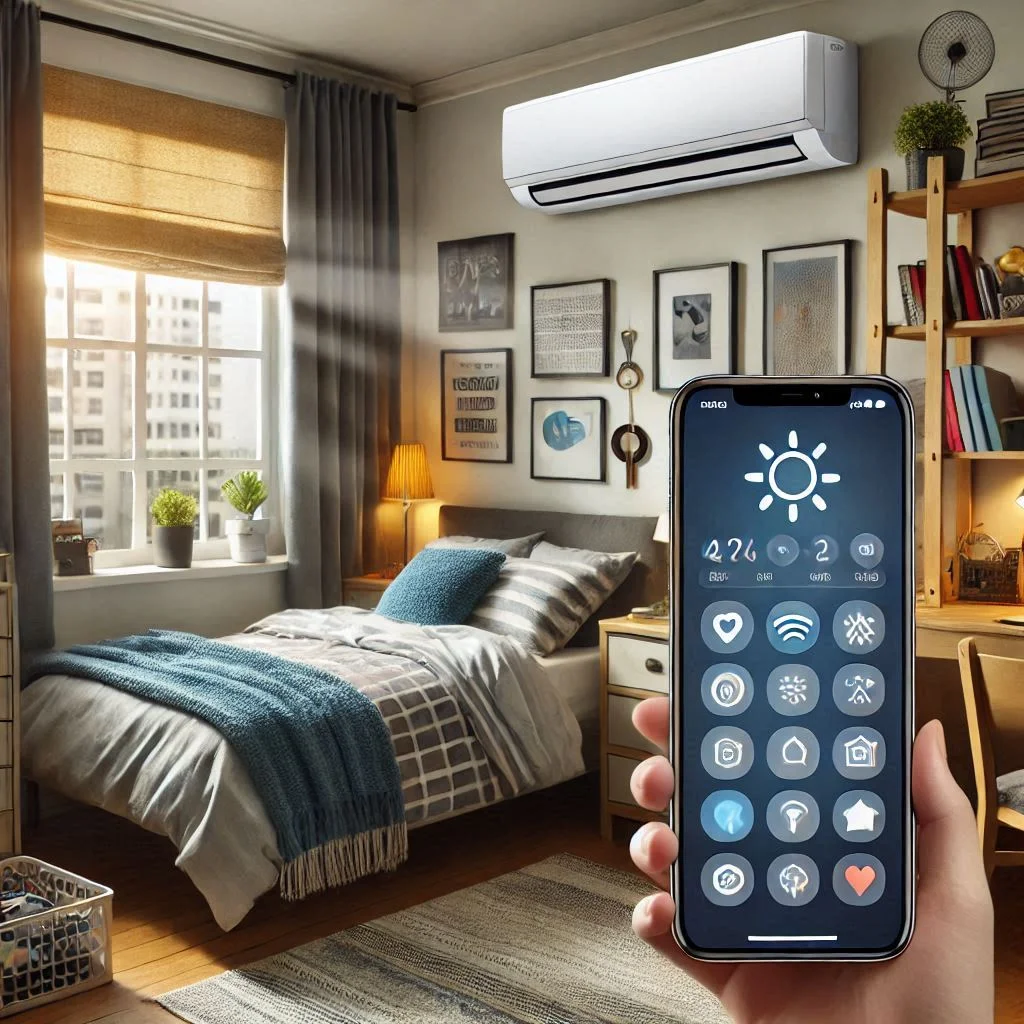
Sizing
When choosing the right air conditioner for your dorm room, sizing is one of the most important factors to consider. If the AC is too small, it will struggle to cool the space, while a unit that’s too large can result in inefficient cooling and higher energy consumption.
How to Choose the Right Size:
- BTU Rating: The cooling capacity of air conditioners is measured in British Thermal Units (BTUs). For dorm rooms, a unit with a BTU range of 8,000 to 12,000 is typically sufficient for most spaces (150-400 square feet).
- Room Size: Measure your dorm room’s square footage to determine the appropriate BTU rating. If your room is larger, opt for a more powerful AC unit.
- Climate Considerations: If you live in a particularly hot climate, consider choosing a slightly higher BTU rating for better performance.
Why It’s Important for Dorm Rooms
Proper sizing ensures that your air conditioner will cool your room efficiently without wasting energy. A correctly sized AC unit will work more effectively and reduce energy costs over time.
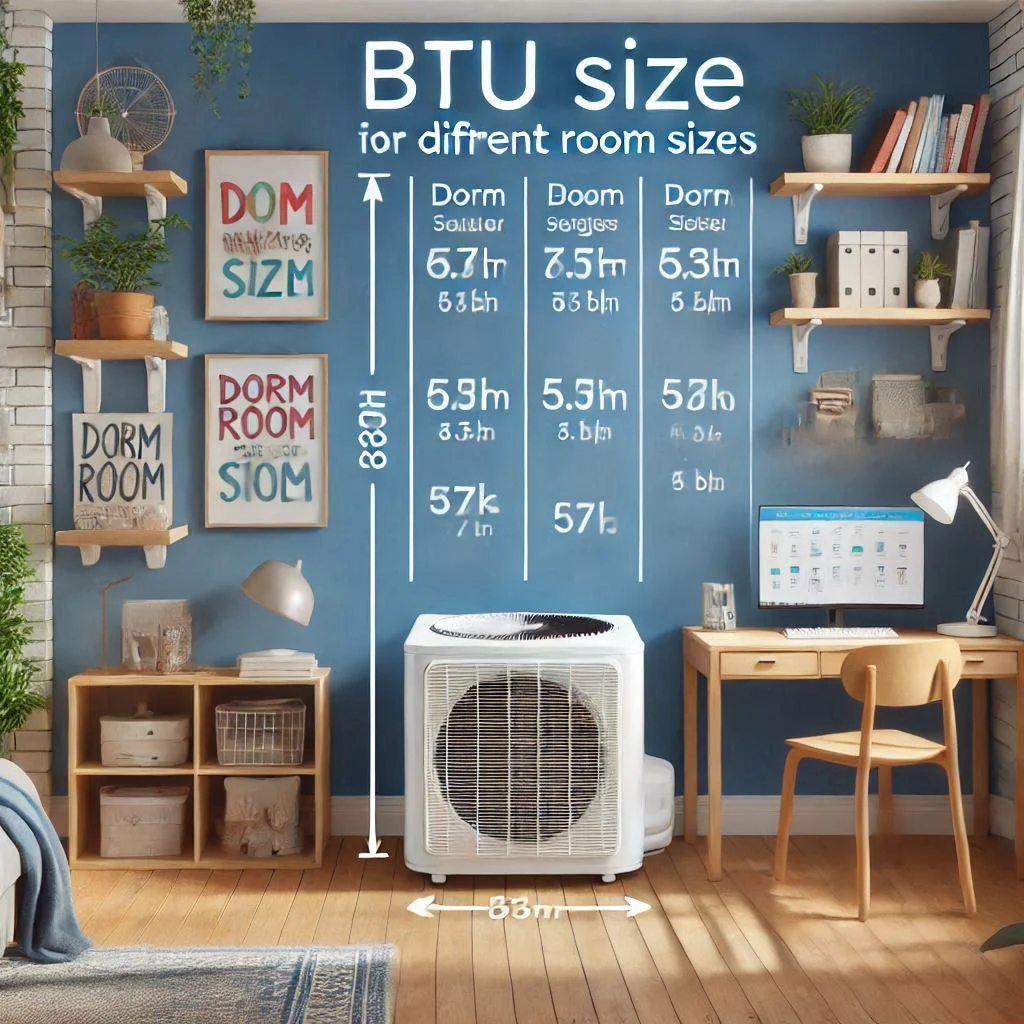
Noise
For students, noise levels can significantly impact sleep quality and study productivity. Noise levels in portable air conditioners can vary widely, and it’s important to choose a model that operates quietly.
How to Reduce Noise:
- Check the decibel rating: Look for models with a noise level below 55 dB, as these are generally quieter.
- Units with sleep mode: Many air conditioners feature a sleep mode that reduces noise as well as energy consumption during the night.
- Inverter technology: Inverter-based ACs operate more quietly and efficiently by adjusting the compressor speed based on the room’s cooling needs.
Why It’s Important for Dorm Rooms
Dorm rooms are often small and may be shared with roommates, so choosing a quiet AC unit ensures that you won’t disturb others. A low-noise air conditioner will help you sleep better, study without distractions, and maintain a peaceful living space.
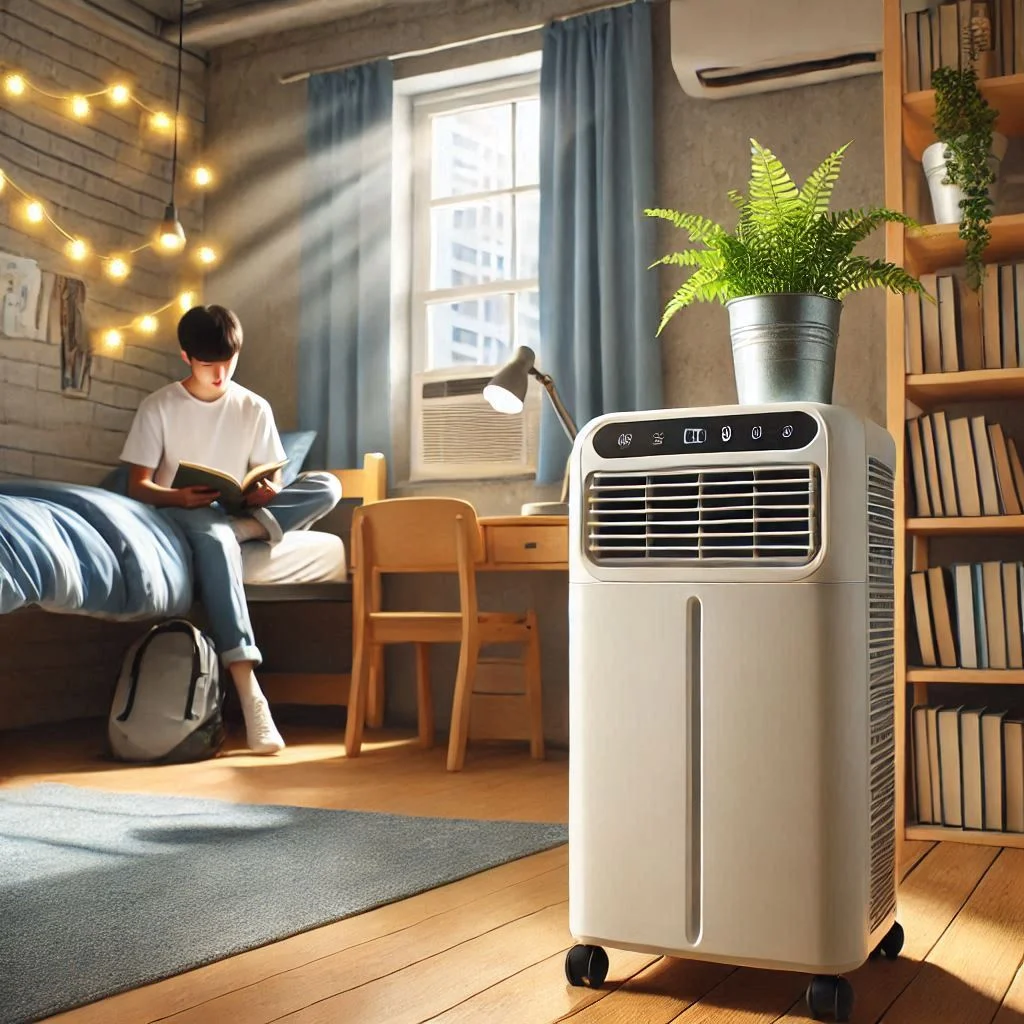
Placement
Where you place your air conditioner in the dorm room can affect its performance. Placement plays a crucial role in optimizing the cooling effect and ensuring that the air circulates properly throughout the room.
Tips for Proper Placement:
- Away from direct sunlight: Avoid placing the AC in direct sunlight, as it can reduce its cooling efficiency. Ideally, position it near a window or on an exterior wall.
- Clear airflow: Ensure that the vents and airflow are not obstructed by furniture or curtains. This allows the air conditioner to operate at maximum efficiency.
- Near the bed or desk: Place the AC where it can effectively cool the area where you spend the most time, such as near your bed or study desk.
Why It’s Important for Dorm Rooms
Proper placement helps the air conditioner cool the room more effectively and evenly. It can also prevent overheating and reduce strain on the unit, ensuring a longer lifespan and more efficient cooling.
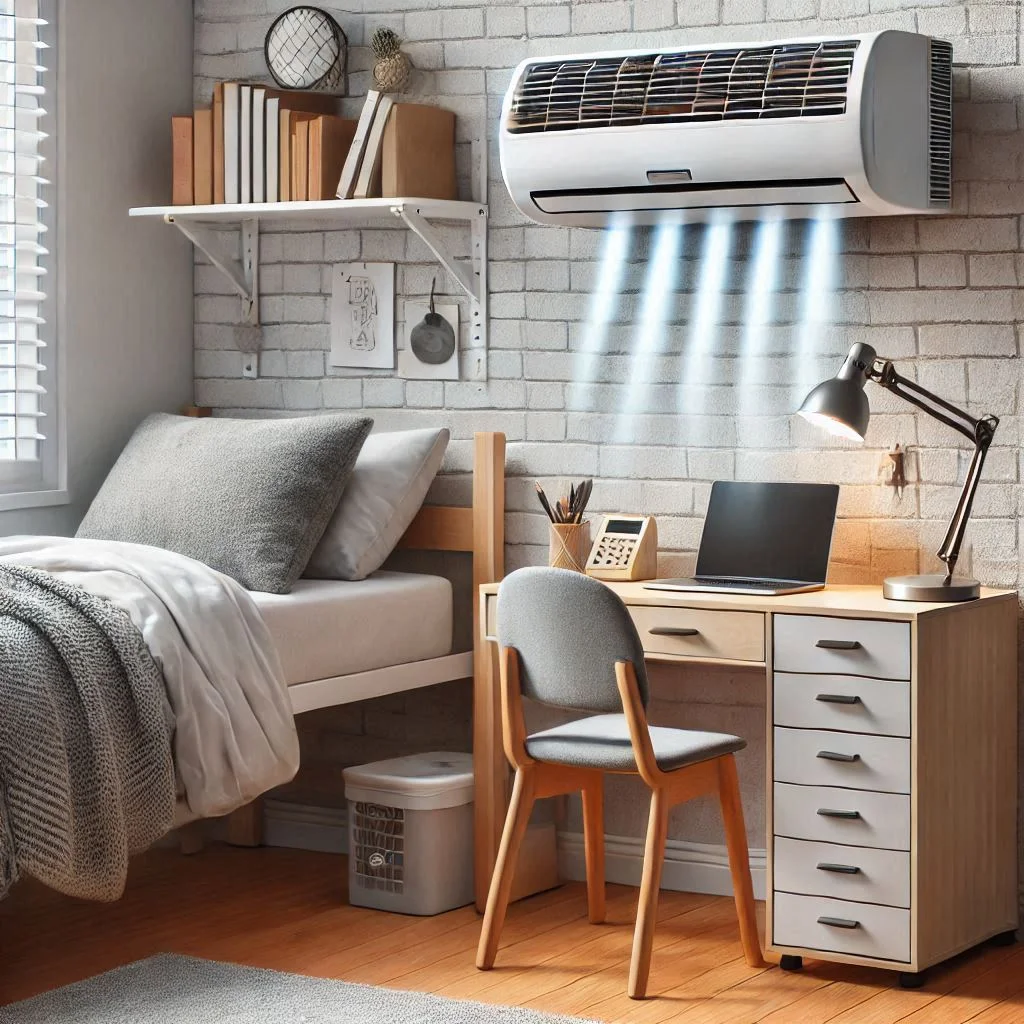
Efficiency
Energy efficiency is one of the most critical features when selecting a dorm room air conditioner. As a student, you likely want to reduce energy bills while still enjoying a cool room. Choosing an energy-efficient AC will ensure that you’re not paying for unnecessary power consumption.
How to Ensure Efficiency:
- Energy Star ratings: Look for units with an Energy Star label. These models meet strict efficiency guidelines set by the U.S. Environmental Protection Agency.
- Inverter technology: Air conditioners with inverter technology adjust the compressor speed based on cooling needs, ensuring that the unit runs more efficiently.
- Eco modes: Many modern air conditioners come with an eco mode, which automatically adjusts settings to optimize energy consumption.
Why It’s Important for Dorm Rooms
Being energy-efficient helps keep your electricity bills lower while also promoting environmental sustainability. With an energy-efficient AC, you can stay cool without worrying about high costs.
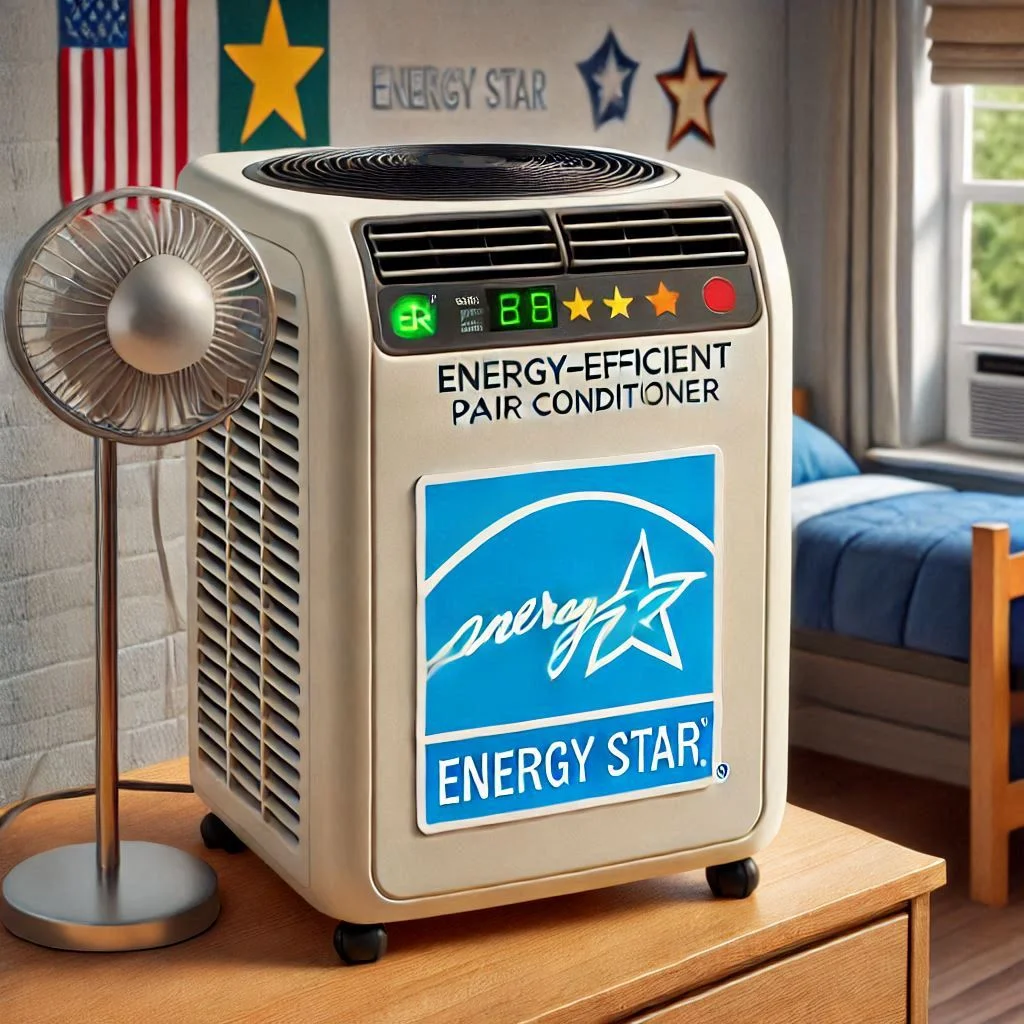
Tips for Cooling Your Dorm Room Without an Air Conditioner
Air conditioning can be a luxury, especially for students in dorms on a budget. However, there are several ways you can keep your dorm room cool and comfortable without relying on an air conditioner. These tips can help reduce the temperature in your room, improve airflow, and increase comfort while saving energy and money.
Purchase a Fan
One of the easiest and most cost-effective ways to cool a dorm room without an air conditioner is by using a fan. A fan works by circulating air throughout the room, creating a cooling breeze that can help lower the temperature.
Types of Fans for Dorm Rooms:
- Box fans: These are compact and can be placed in windows to draw cool air in from outside or push hot air out.
- Tower fans: Tall and slim, these fans are perfect for small spaces like dorm rooms, and they often come with multiple speed settings.
- Oscillating fans: These fans rotate back and forth to circulate air over a larger area, helping to cool the entire room.
Why It’s Effective:
Fans work by increasing the evaporation of sweat from your skin, which naturally cools you down. Even on hot days, fans can make a big difference in comfort.
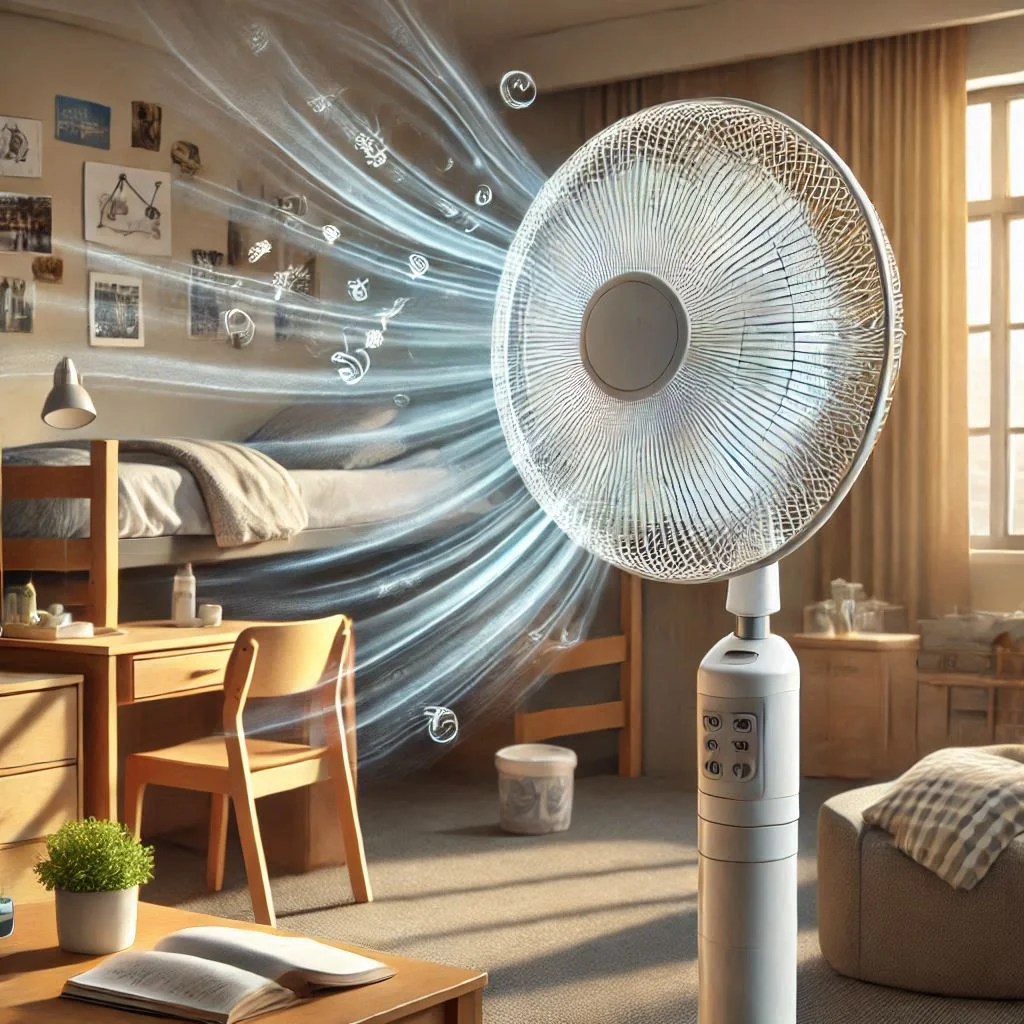
Keep Your Blinds Closed
Keeping your blinds closed during the day is an effective way to reduce the amount of heat entering your dorm room. Direct sunlight can increase the temperature in your room significantly, especially during peak daylight hours.
How to Maximize the Effectiveness of Blinds:
- Use blackout curtains: These curtains block out light completely and keep the room cooler. They also reduce heat transfer through the windows.
- Opt for reflective window film: This film reflects sunlight away from the room, further preventing heat buildup.
Why It’s Important:
Blocking sunlight not only keeps your room cooler but also prevents your AC or fan from working overtime. This tip can have a significant impact on how much heat accumulates during the day.

Invest in a Cold Mist Humidifier
A cold mist humidifier can help cool your dorm room by adding moisture to the air. Humidifiers increase the air’s water content, which can make the room feel cooler and more comfortable, especially in dry conditions.
Benefits of a Cold Mist Humidifier:
- Cooler air: The mist released helps reduce the perceived temperature in the room.
- Better sleep quality: Moist air is easier to breathe, which can improve your sleep quality, especially if you struggle with dry air.
- Preventing dryness: Helps prevent your skin from drying out, which is particularly helpful during the colder months.
Why It’s Effective:
Cold mist humidifiers can create a more pleasant and breathable atmosphere, and the cooling effect can be very noticeable during hot nights.
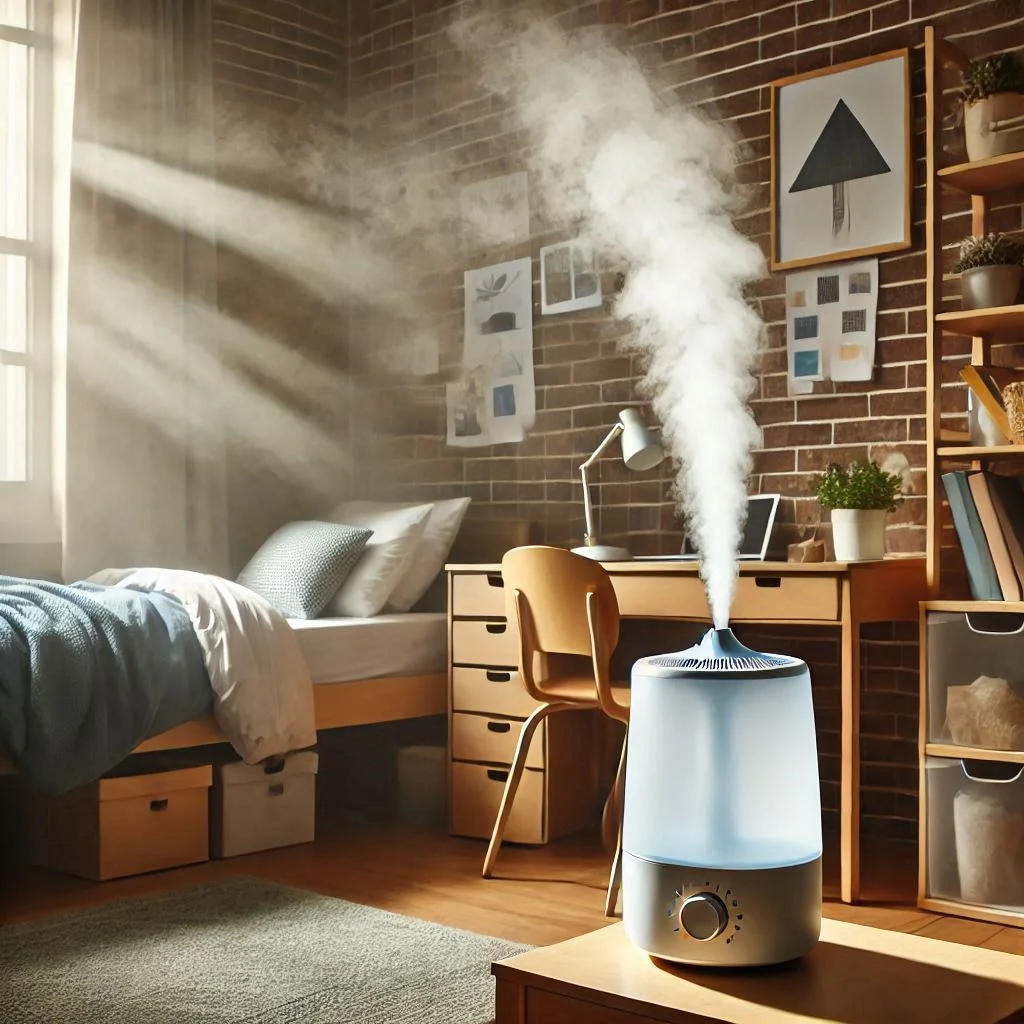
Turn Off Unnecessary Electrical Appliances
Many electrical appliances generate heat, and leaving them on can raise the temperature in your dorm room. Turning off unnecessary electrical devices, like computers, lights, and kitchen appliances, can help reduce heat buildup and make your room cooler.
Items to Turn Off:
- Laptops or desktop computers: These devices produce a lot of heat, especially when running for extended periods.
- Lights: Incandescent bulbs can generate heat, so consider using LED lights, which are energy-efficient and produce less heat.
- Other electronics: Appliances like toasters, hairdryers, or space heaters should be turned off when not in use.
Why It’s Effective:
Reducing heat sources within your room will lower the overall temperature, making the air feel fresher and cooler. This is an easy, energy-efficient way to stay comfortable.

Shower Before Bed
Taking a cool shower before bed is one of the simplest ways to cool down your body temperature and prepare for a good night’s sleep. A cool shower lowers your body’s internal temperature, making you feel refreshed and comfortable.
How a Cool Shower Helps:
- Reduces body temperature: It helps cool your body down after a hot day, making it easier to fall asleep.
- Soothes the skin: A cool shower can provide instant relief from heat and prevent sweating at night.
- Improves sleep quality: By lowering your body temperature, you signal to your body that it’s time to relax and rest.
Why It’s Effective:
Taking a shower before bed is an instant and effective way to cool your body down and improve sleep quality, making it an excellent addition to your cooling routine.

How Much Does a Portable Air Conditioner Cost for Dorm Rooms?
When looking for a portable air conditioner (AC) for your dorm room, understanding the cost is crucial. The price of portable AC units can vary depending on several factors such as brand, features, and capacity. This guide will break down the price range of portable air conditioners and the factors influencing their cost to help you make an informed decision.
Price Range of Dorm Room Portable AC Units
Portable air conditioners are a great solution for dorm rooms because they are compact, easy to move, and don’t require permanent installation. The price of these units varies widely depending on their size, functionality, and brand.
Price Range Overview:
- Budget Range ($150 – $250):
At this price, you can expect a basic model with essential features like cooling and a fan mode. These are typically smaller units, ideal for smaller dorm rooms (up to 250 sq. ft.). These AC units may lack advanced features like Wi-Fi connectivity or heating options.- Example: Black+Decker BPACT08WT Portable Air Conditioner
- Mid-Range ($250 – $400):
In this range, portable AC units tend to offer better cooling capacity, advanced features like dehumidification, and improved energy efficiency. They may cool rooms up to 350 sq. ft. and have additional functionalities, including remote control or a higher BTU rating.- Example: LG 250 Sq. Ft. Portable Air Conditioner
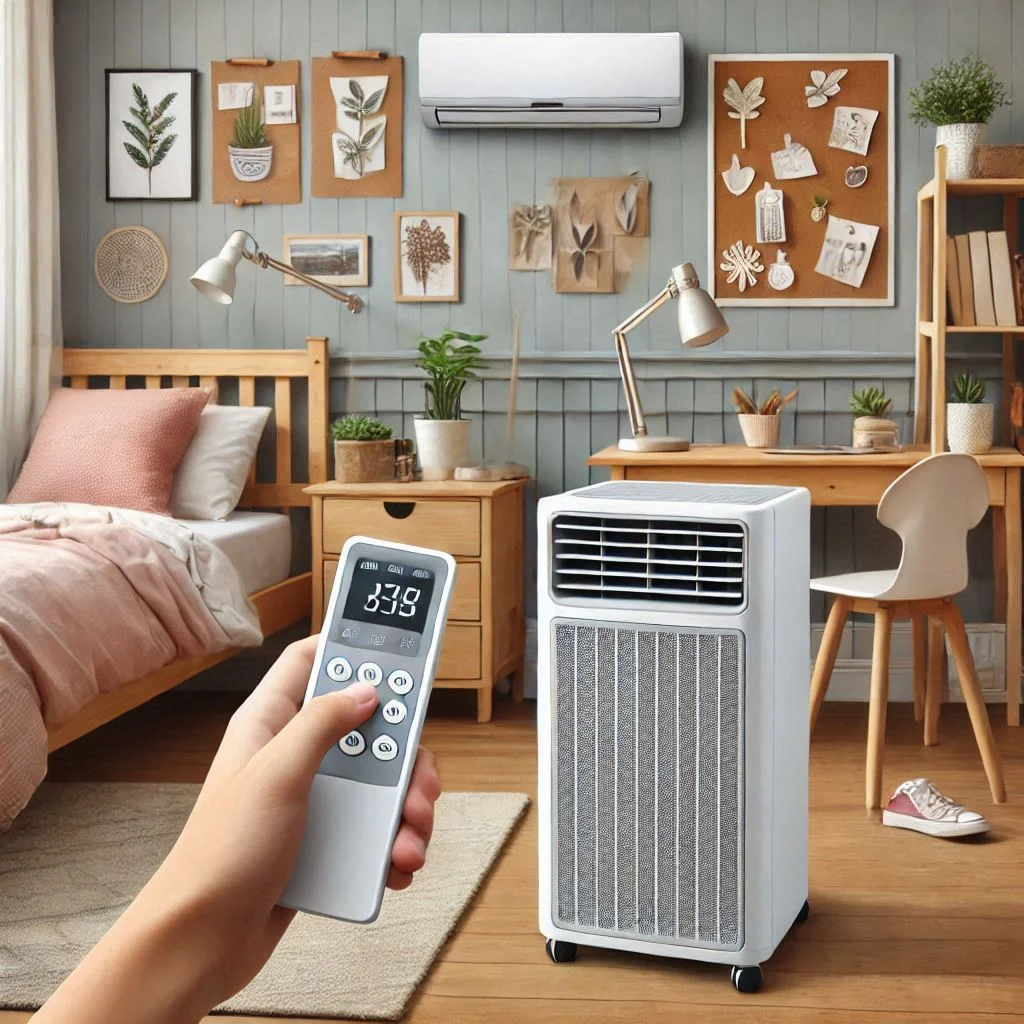
- Premium Range ($400 – $600+):
Premium portable air conditioners offer higher cooling capacities (up to 400 sq. ft. or more), better energy efficiency, additional features like smart functionality or heating options, and quieter operation. These units are ideal for larger dorm rooms or if you want multi-season use.- Example: Whynter 400 Sq. Ft. Portable Air Conditioner and Heater
Why the Price Varies:
The price of portable AC units is primarily driven by their cooling capacity (BTU), energy efficiency, brand reputation, and additional features.
Factors Influencing the Cost of Portable Air Conditioners
Several factors impact the cost of portable air conditioners. Understanding these can help you decide which features are necessary for your dorm room and which ones can be compromised to fit your budget.
1. Cooling Capacity (BTU Rating):
The cooling capacity of a portable AC unit is measured in British Thermal Units (BTUs). Higher BTU ratings indicate that the unit can cool a larger space. Units with higher BTUs generally come with a higher price tag, so if you need to cool a larger room or want faster cooling, expect to pay more.
- Small Dorm Rooms (up to 250 sq. ft.): 6,000 to 8,000 BTUs
- Medium Dorm Rooms (up to 350 sq. ft.): 8,000 to 10,000 BTUs
- Large Dorm Rooms (up to 400 sq. ft. or more): 10,000 BTUs or more
2. Energy Efficiency:
Energy-efficient portable air conditioners are generally more expensive upfront but can save you money on electricity bills over time. Look for units with an Energy Star rating to ensure you’re purchasing an energy-efficient model.
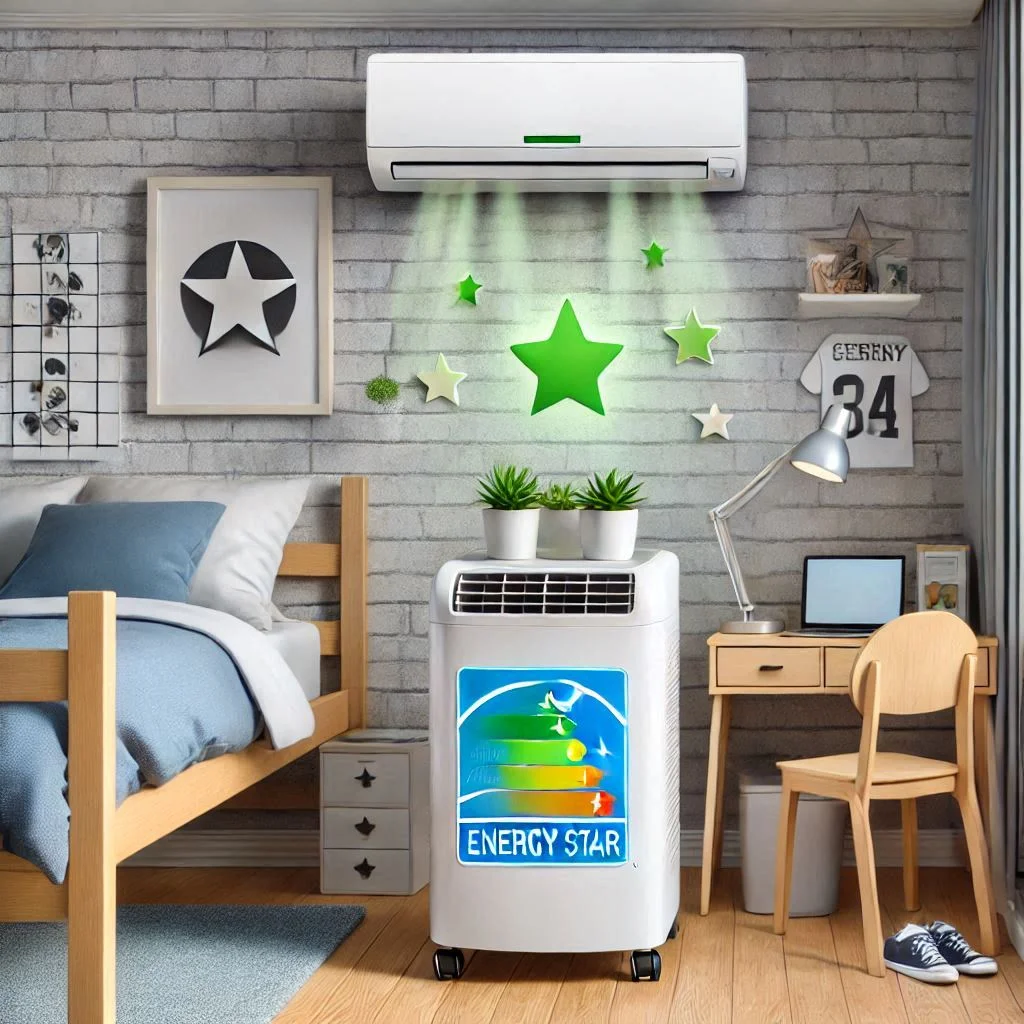
3. Features and Functionality:
Portable air conditioners with additional features such as smart functionality, dehumidifiers, remote controls, and heating capabilities will cost more than basic models. Smart features like Wi-Fi connectivity, which allows you to control the unit remotely, are also a premium feature.
4. Brand:
Well-known brands such as Frigidaire, Whynter, Honeywell, and LG tend to price their units higher due to their reputation for quality, durability, and customer service. Lesser-known brands may offer more affordable options, but they might not be as reliable or efficient.
5. Portability and Design:
Some units are designed with more portable features such as casters, compact build, or sleek designs, which may increase the price. These features make the unit easier to move and store, but they come with an added cost.
6. Noise Level:
Units that are quieter during operation may cost more, as quieter models tend to use advanced technology to reduce noise. If noise is an important consideration in your dorm room, you may want to invest in a unit designed with low-noise technology.
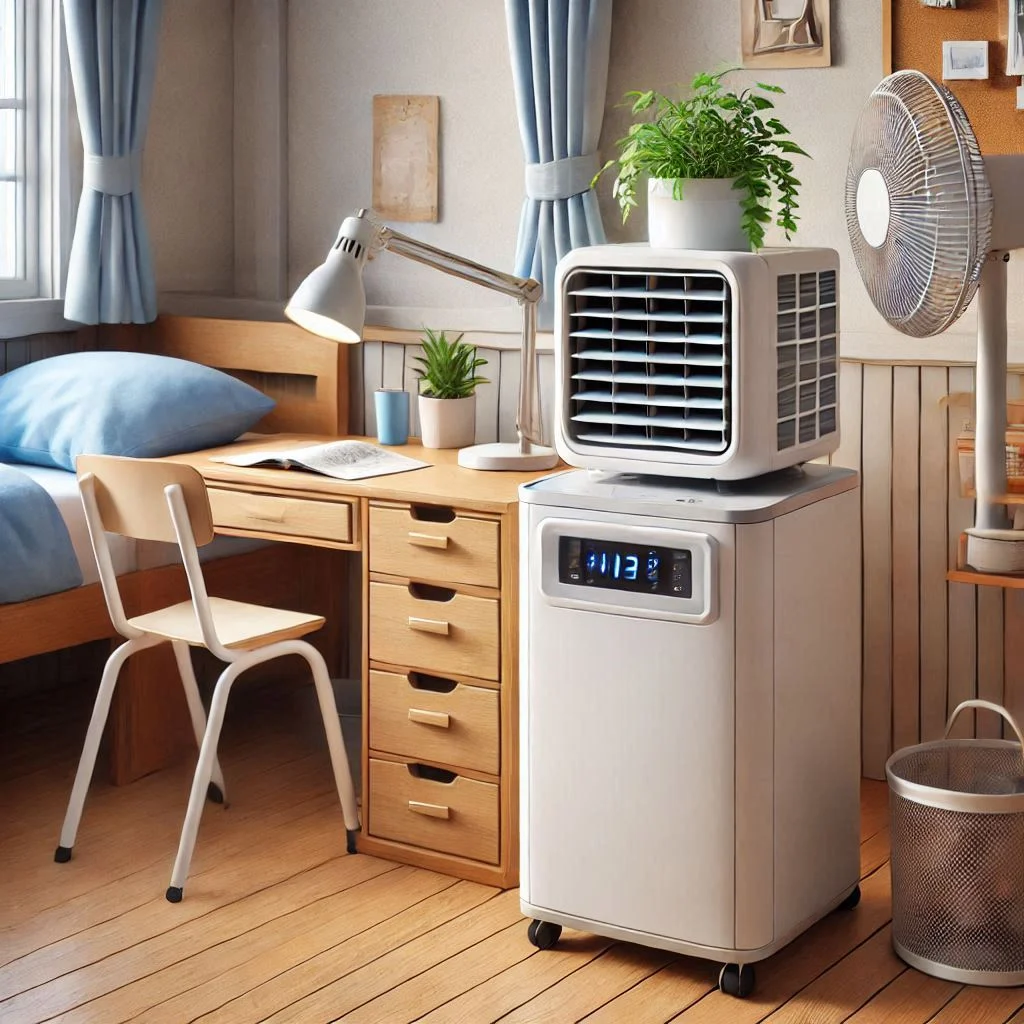
FAQ: How Much Does a Portable Air Conditioner Cost for Dorm Rooms?
When considering purchasing a portable air conditioner for your dorm room, you may have some key questions about pricing and what factors influence it. This FAQ section addresses common questions to help you make an informed decision. We’ve also provided additional insights for a better understanding of portable AC unit costs.
1. What is the average price of a portable air conditioner for a dorm room?
The average price of a portable air conditioner (AC) for a dorm room typically ranges from $150 to $600. The price varies based on factors such as the unit’s cooling capacity (BTU), energy efficiency, added features, and brand.
- Budget-friendly models ($150-$250) are smaller units designed for cooling smaller spaces like dorm rooms up to 250 sq. ft.
- Mid-range models ($250-$400) are slightly larger and feature additional functionalities like dehumidification, remote control, and higher BTUs for medium-sized dorm rooms.
- Premium models ($400-$600+) offer superior cooling power, smart features (like Wi-Fi control), and heating options for year-round use.
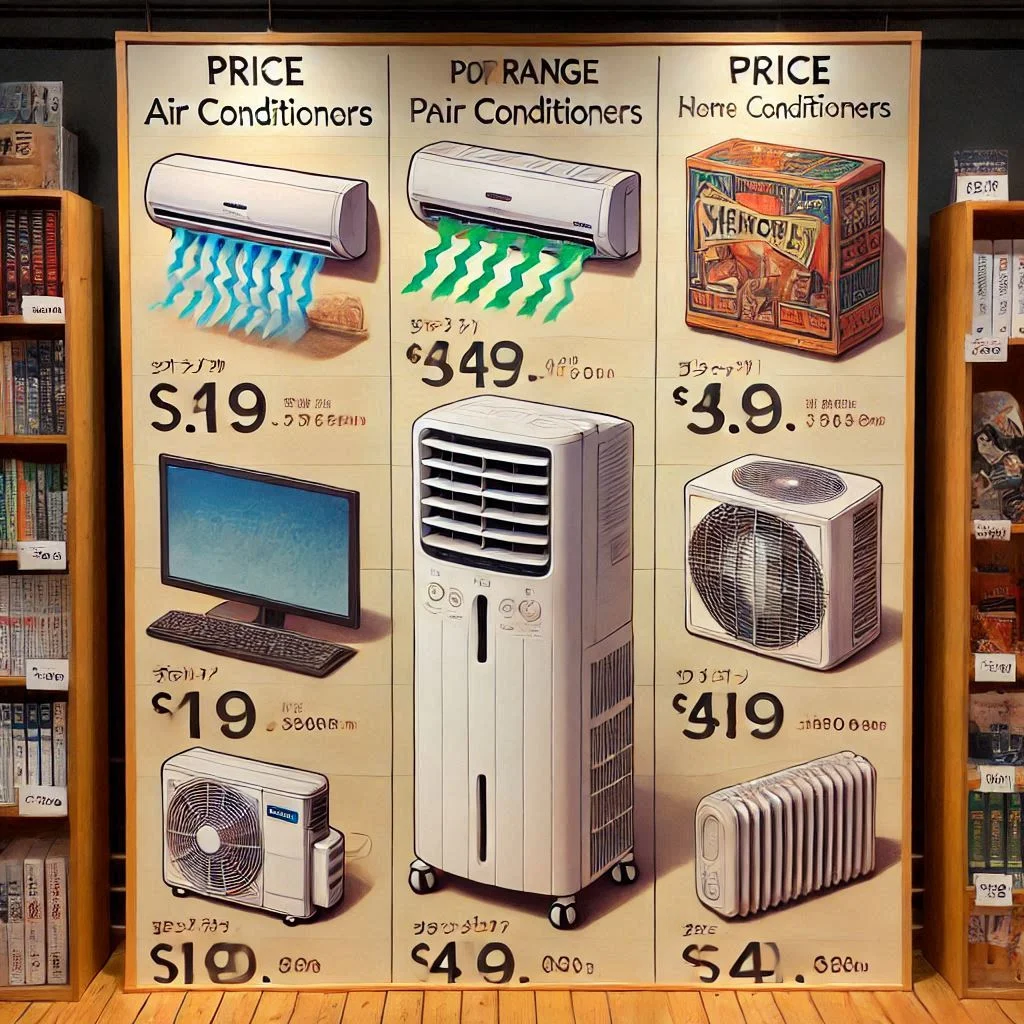
2. Why do portable air conditioners vary in price?
Portable air conditioners vary in price due to a combination of factors. The main determinants are:
- Cooling Capacity (BTU): Higher BTUs result in more cooling power, which is ideal for larger rooms but increases the price.
- Energy Efficiency: Energy-efficient models (often Energy Star-rated) tend to cost more upfront but save money on electricity bills over time.
- Brand: Well-known brands like Frigidaire, Whynter, and LG typically come with a higher price tag due to their reliability and advanced technology.
- Additional Features: Units with smart functionality (Wi-Fi control), dehumidifiers, remote controls, and multi-season use (cooling and heating) will generally be priced higher.
- Design and Portability: Sleek designs and easy portability features, like smooth-rolling casters, increase the cost.

3. Are higher-priced portable air conditioners worth the extra cost?
Higher-priced portable air conditioners can offer significant benefits, but whether they’re worth the extra cost depends on your needs:
- For smaller dorm rooms (under 250 sq. ft.), a budget model will usually suffice and cool the space effectively at a lower price.
- For larger dorm rooms (over 300 sq. ft.), mid-range to premium models are recommended for optimal cooling, quieter operation, and advanced features like dehumidification and smart controls.
- If you plan to use the unit year-round, a premium model with both cooling and heating functionality may justify the higher price.
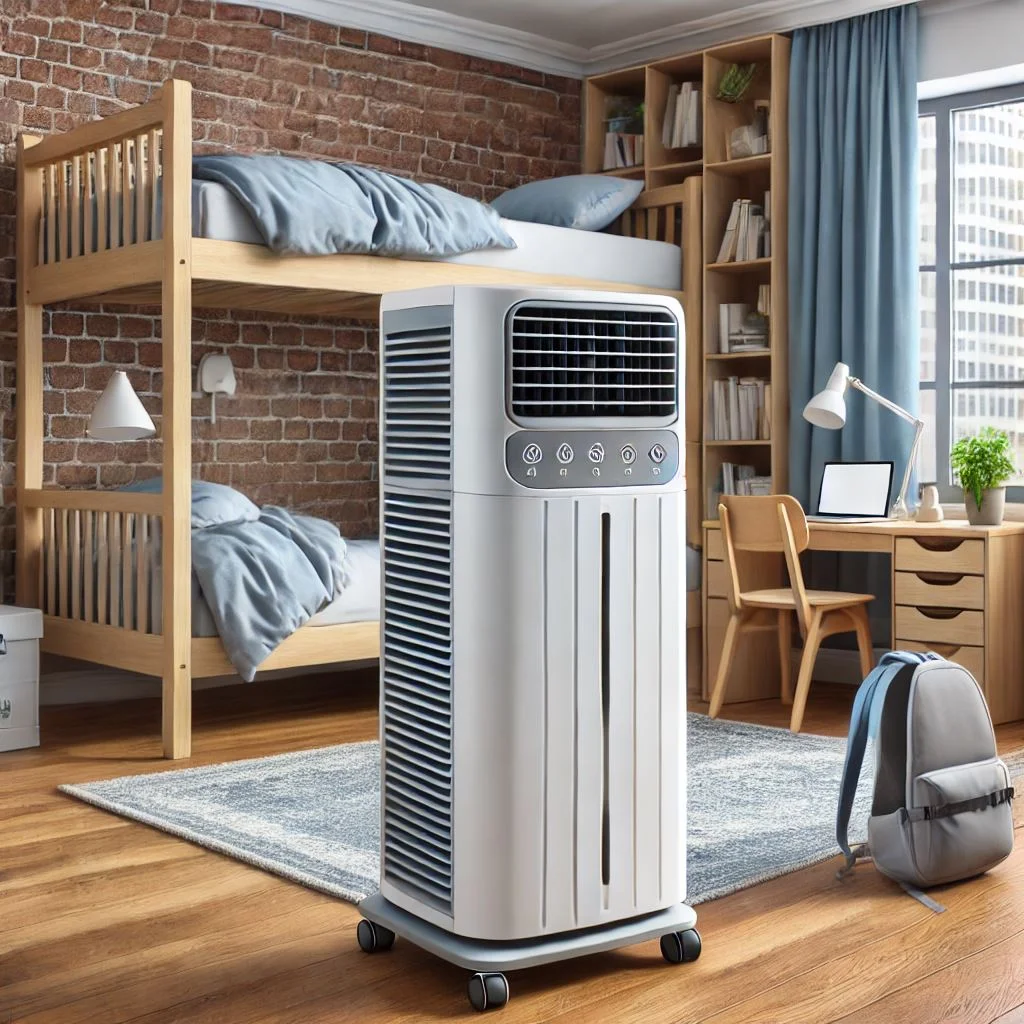
4. What additional costs should I consider when buying a portable air conditioner?
In addition to the upfront cost of the unit, there are some additional costs to keep in mind:
- Electricity Consumption: Portable AC units use significant energy. Energy-efficient models help minimize ongoing electricity costs, while less-efficient ones can increase your monthly utility bills.
- Maintenance: Regular maintenance, such as filter cleaning and vent hose replacement, may incur additional costs.
- Extension Cords or Duct Kits: Some portable AC units may require an extension cord or an additional venting kit to work effectively in a dorm room, especially if there are limited window spaces for installation.
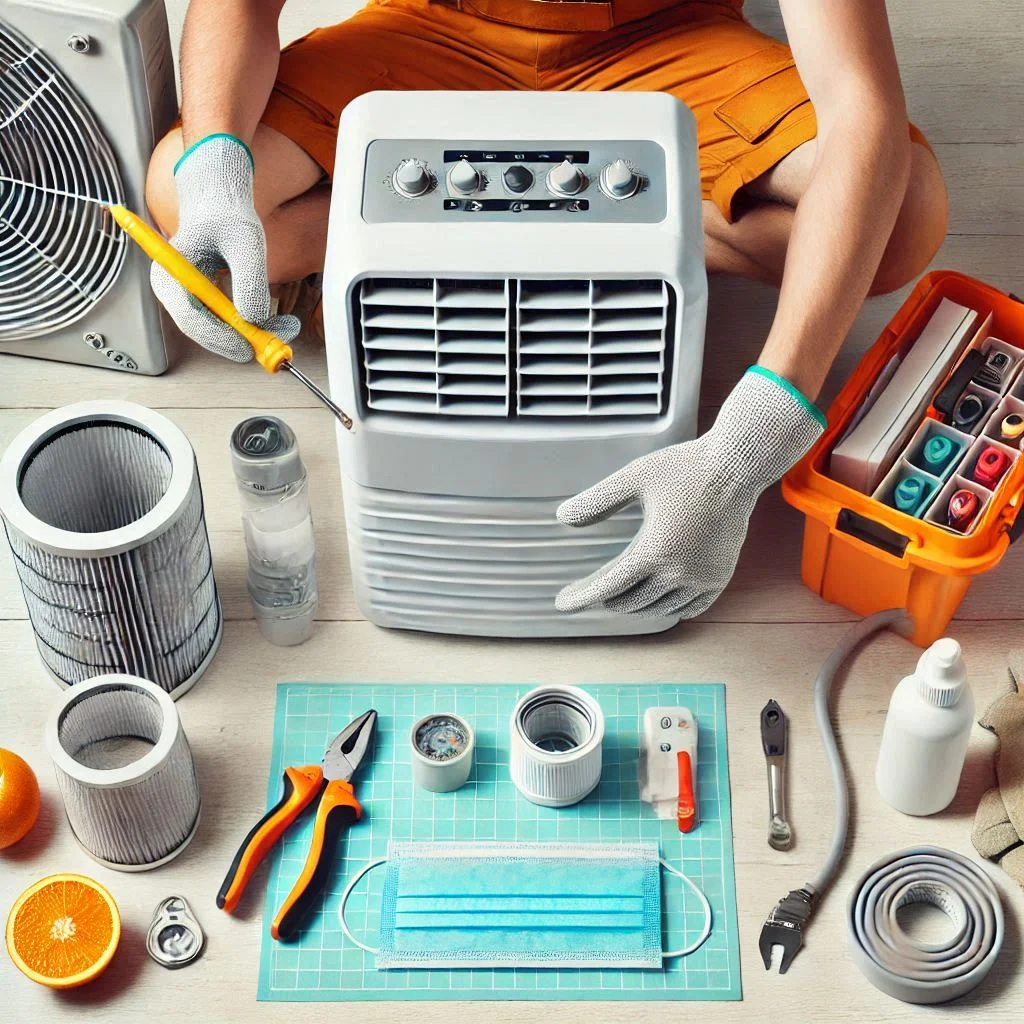
5. What is the best portable air conditioner for a dorm room?
The best portable air conditioner for a dorm room depends on factors like room size, your cooling needs, and desired features. However, some top-rated options include:
- Frigidaire FHPH132AB1 – A compact unit ideal for smaller rooms, offering efficient cooling and a simple interface.
- Black+Decker BPACT08WT – A budget-friendly model that provides excellent cooling for dorm rooms up to 250 sq. ft.
- Whynter 400 Sq. Ft. Portable Air Conditioner and Heater – For larger dorm rooms, this unit offers both cooling and heating options, perfect for year-round use.
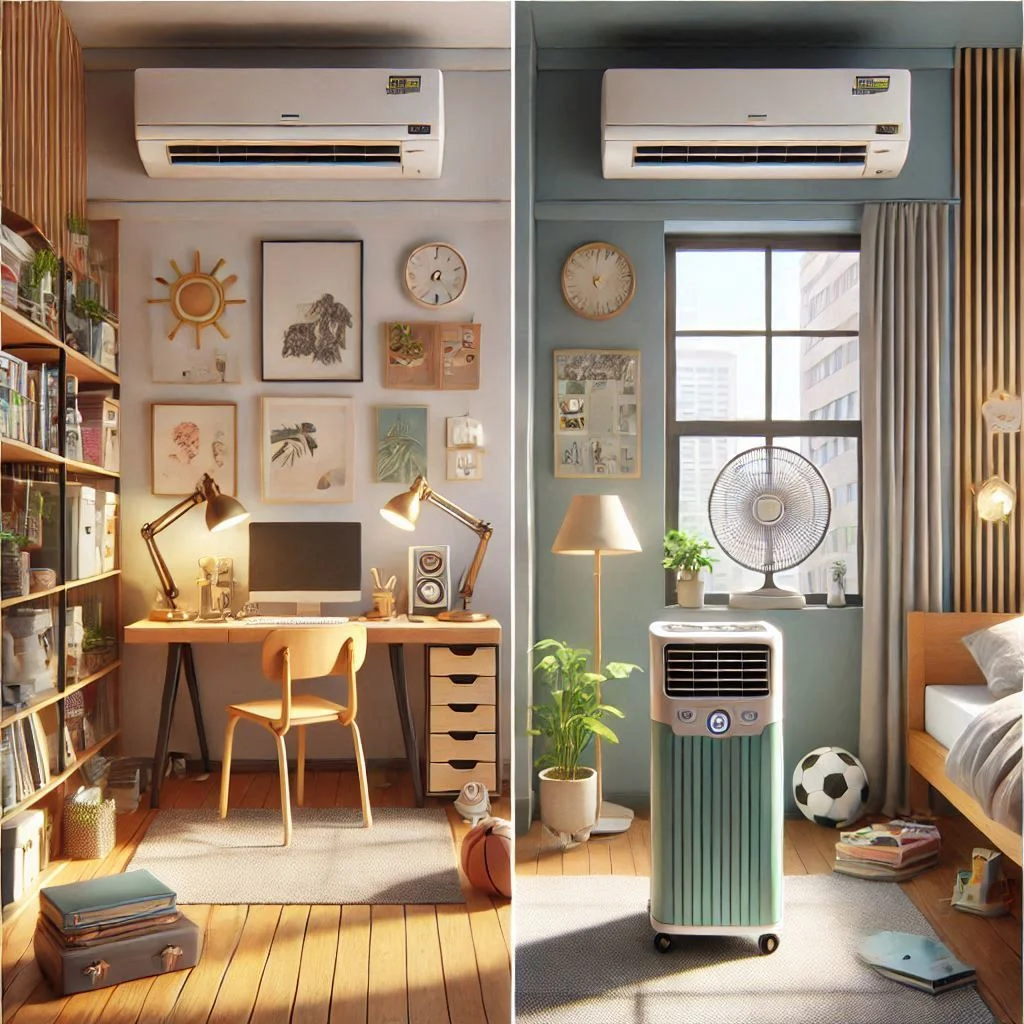
6. How can I save money on a portable air conditioner for my dorm room?
To save money on a portable air conditioner for your dorm room:
- Choose the right size: Select a model with the appropriate BTU for your room size. Over-sized units waste energy, while under-sized units will be less effective.
- Look for Energy Star models: These units are more energy-efficient and will reduce your electricity bills over time.
- Shop during off-seasons: Purchase your unit during the off-season (fall or winter) when prices may be lower.
- Consider refurbished models: You can save money by buying certified refurbished units that are in excellent condition.
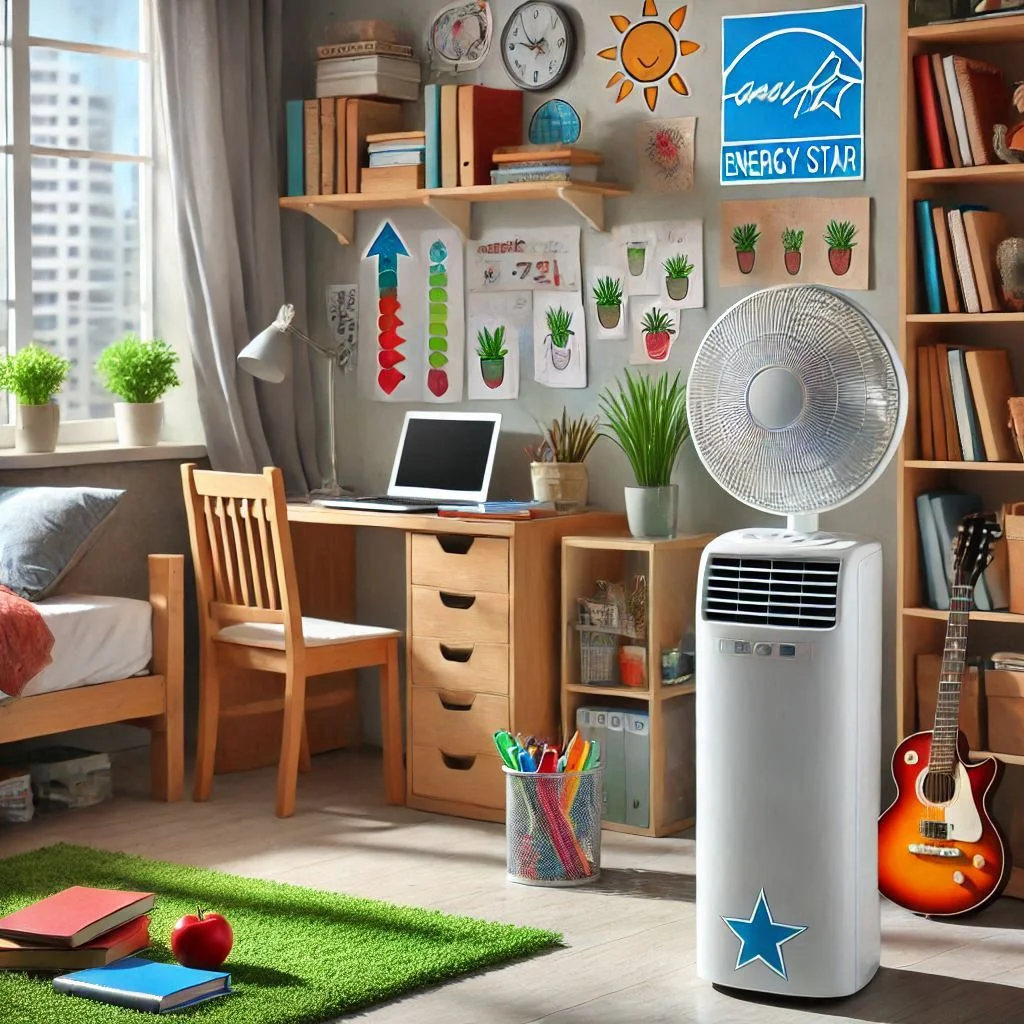
Conclusion
In conclusion, selecting the best portable air conditioner for your dorm room involves understanding your specific cooling needs, room size, and budget. By carefully considering factors like cooling capacity, energy efficiency, noise levels, and additional features, you can find an ideal unit that enhances your comfort without breaking the bank. Whether you choose a budget-friendly model or invest in a premium, multi-functional unit, it’s essential to make an informed decision that suits both your immediate and long-term needs. Moreover, for those looking for alternatives, there are effective methods to cool your dorm room without an AC. Regardless of your choice, the right air conditioning solution will make your dorm experience much more comfortable and enjoyable.

